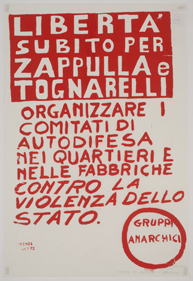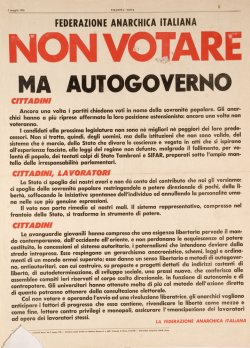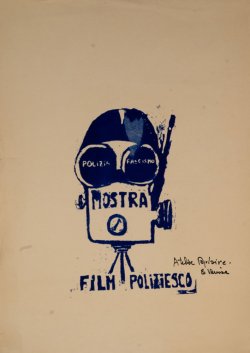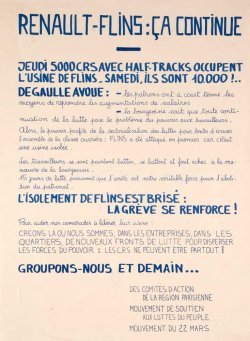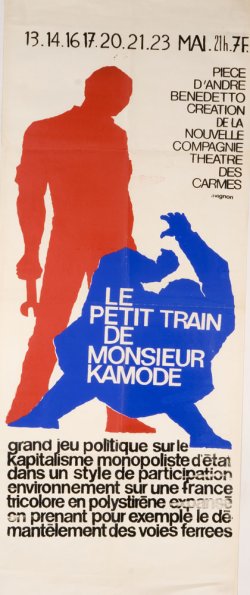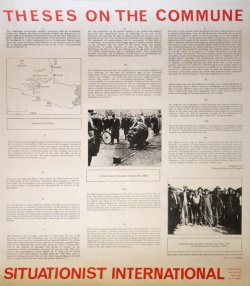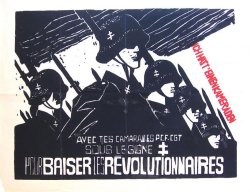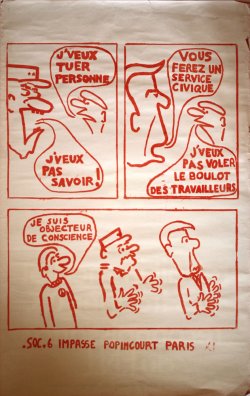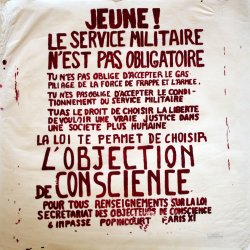papier blanc
2277 affiches :
- notice : Image (fixe ; à 2 dimensions)
- notes :
- descriptif :
texte
une du Petit journal (supplément illustré du dimanche 5 mai 1912) avec dessin (scène d’attaque de banque : « À Chantilly, l’attaque de la succursale de la Société Générale »)
- texte :
Les anarchistes ou
La Bande à Bonnot
Intermondia films
Jean-Paul Guibert
présenteJacques Brel
Bruno Cremer
Annie Girardot
Jean-Pierre Kalfondans
Les anarchistes ou
La Bande à Bonnotun film de
Philippe FourastiéDialogues de Marcel Jullian
scénario original et adaptation
Jean-Pierre Beaurenaut • Pierre Fabre
Philippe Fourastié • Rémo Forlanoavec
Armand Mestral
Francis Dyrek • Dominique Maurin
Michel Vitold • Anne WiazemskyMusique de
François Rauver et Jacques Brel
édition [… …]Co-production franco-italienne
Intermedia Films Jean-Paul Guibert (Paris)
Kinesis Films • Mefa Film (Rome)Interdit aux moins de 18 ans
Eastmancolor[impr. … ]
[graphiste …]
Affiche de cinéma. Titres alternatifs : La bande à Bonnot (titre français simplifié, le plus fréquemment employé) / Bonnot’s Gang (titre international) / Anarkisterna (Suède) / De anarchisten of de bende van Bonnet (Pays-Bas) / La banda Bonnot (Italie) / Os Gangsters de Bonnot (Brésil)
- notice : Image (fixe ; à 2 dimensions)
- notes :
- descriptif :
[ texte avec signature cerclé ]
- texte :
Libertà subito per Zappulla e Tognarelli
Organizzare i comitati di autodifesa nei quartieri e nelle fabbriche
contro la violenza della statoGruppi anarchici
[…]
- notice : Image (fixe ; à 2 dimensions)
- notes :
- descriptif :
[ texte (journal mural) ]
- texte :
4 maggio 1968 Umanità Nova
Federazione Anarchica Italiana
Non votare
Ma autogoverno
Cittadini
Ancora una volta i partiti chiedono voti in nome della sovranità popolare. Gli anarchici a più riprese affermato la loro posizione astensionista : ancora una volta non voteranno.
I candidati alla promissa legislatura non sono nè migliori nè peggiori dei loro predecessori. Non si tratta, quindi, degli uomini, ma delle istuzioni che non sono valide, del sistema che è marcio, dello Stato che divora le coscienze e vegeta in atti che si ispirano all’esperienza fascista, alle leggi del regime non defunto, malgrado il fallimento, per volontà di popolo, dei tentati colpi di Stato Tambroni e SIFAR, preparati sotto l’ampio mantello delle irresponsabilità parlamentari.
Cittadini, lavoratori
Lo Stato ci spoglia dei nostri averi e non dà conto del contributo che noi gli versamio : ci spoglia della sovranità popolare restringendola a potere direzionale di pochi, della libertà, soffocando le iniziative spontanee dell’individuo ed annullando la personalità umana nelle sue più genuine espressioni.
Il voto non porta rimedio ai nostri mali. Il sistema rappresentativo, compresso nel frantoio dello Stato, si trasforma in strumento di potere.
Cittadini
Le avanguardie giovanili hanno compresso che una esigenza libertaria pervade il mondo contemporaneo, dall’occidente all’oriente, e non perdonano le acquiescenze al potere costituito, le concessioni al sistema autoritario, i paternalismi che intendono deviare dalla strada intrapresa. Esse respingono un gerarchismo anacronistico, schemi, leggi e ordinamenti di un mondo ormai superato ; esse danno un senso libertario a metodi di autogoverno, antiautoritari, con cui costruire, su proposte e progetti deddati da indirizzi costanti di libertà, di autodeterminazione, di sviluppo sociale, una prassi nuova, che conferisca alle assemblee compiti ieri riservati al corpo scelto direzionale, in funzione di autonomia e di contropotere. Gli universitari hanno ottenuto molto di più col metodo dell’azione diretta di quanto potranno attenere dalla consultazione elettorale.
Col non votare e operando l’avvio ad una rivoluzione liberatrice, gli anarchici vogliono anticipare i fattori di progresso che essa contiene, rivendicare la libertà come mezzo e come fine, lottare contro privilegi e monopoli, assicurare l’emancipazione dei lavoratori ad opera dei lavoratori stessi.
La Federazione Anarchica Italiana
[Supplemento al n. … di] « Umanità Nova » del 4 maggio 1968 — Giornale murale Iscritto sul Registro Stampa al n. 4891, Tribunale di Roma, 31-10-1955 — Stabilimento tipografico GATE ; Roma
- notice : Image (fixe ; à 2 dimensions)
- notes :
- descriptif :
sept. 1968 [ texte ]
- texte :
Padroni e sindacato sono d’accordo sul contratto bidone, ma noi no
Semble disparue du catalogue du Cira L
- notice : Image (fixe ; à 2 dimensions)
- notes :
- descriptif :
[ patron et médecin assis sur une seringue piquent le bras d’un autre personnage à casquette d’ouvrier au bras en forme de toit d’usine ]
- texte :
Più affari facciamo più malati ci sono
Congresso di medicina del lavoro
Più malati ci sono più affari facciamo
ot. 68
movemento Studentesco AP
Signature AP pour "Atelier populaire" ?
- notice : Image (fixe ; à 2 dimensions)
- notes :
- descriptif :
[ texte (manuscrit) ]
- texte :
Point n° 7 de la déclaration du Living-theatre
« Nous quittons le festival parce que le temps est venu pour nous de commencer enfin à refuser de servir ceux qui veulent que la connaissance et le pouvoir de l’art appartiennent seulement à ceux qui peuvent payer, ceux-là mêmes qui souhaitent maintenir le peuple dans l’obscurité, qui travaillent pour que le pouvoir reste aux élites, qui souhaitent contrôler la vie de l’artiste et celle des autres hommes. »
Pour nous aussi la lutte continue
[tampon :] AP Avignon
Voir aussi : « Treize questions aux organisateurs et aux participants du festival d’Avignon ».
- notice : Image (fixe ; à 2 dimensions)
- notes :
- descriptif :
[ projecteur avec une casque de policier ]
- texte :
Polizia — Fascismo
mostra
film poliziesco
Rajout manuscrit : "Atelier populaire de Venise".
- notice : Image (fixe ; à 2 dimensions)
- notes :
- descriptif :
[ texte ; image : 2 gravures et 4 photos de dirigeants (Mao Zedong, Mariano Rumor [?], Lyndon B. Johnson [?], Pie VI) ]
- texte :
1 Maggio
Operai le fabbriche sono vostre !
Contro ogni oppressore, contro ogni padrone, contro ogni esercito, contro ogni burocrazia : questo è il nostro 1° Maggio.
Non à la festa per sfilate di potenti eserciti come ormai accade a Mosca, e Pechino e in tutti gli altri paesi socialisti, perché gli eserciti sono sempre contro il popolo e festeggiare un giorno di lotta operaia e rivoluzionaria con l’esibizione della potenza delle armi atomiche significa tradire i valori della eroica guerriglia dei popoli e accettare la logica del terrore dei blocchi di potenze voluto dall’imperalismo del denaro.
Svegliamoci : i partiti vogliono solo il nostro voto, i sindacati fanno gli interessi del padrone, i burocrati sono contro di noi, i dirigenti frenano le nostre lotte.
Rifiutiamo il sistema della pseudo democrazia parlamentare, rifiutiamo ogni dirigenza e ogni tatticismo dei sindacati e dei partiti, ogni mitizzazione di uomini e di fatti, ma uniamoci per abbattere i vertici e arrivare alla gestione collettiva dal basso, alla uguaglianza assoluta e alla affermazione della dignità dell’uomo.
Lavoratore ti ingannano !
Oggi non è la festa del Cristo lavoratore !
Oggi non è una festa patriottica con sfilate di eserciti !
Oggi è invece l’anniversario del sacrificio di cinque lavoratori impicciati per avec proclamato, il 1° Maggio del 1886 a Chicago.
Da oggi non lavoreremo che otto ore !
Da allora il Primo Maggio sarebbe stato giorno di lotta degli sfruttati contro gli sfruttatori, secondo l’incitamento dei cinque lavoratori anarchici morti sul patibolo.
Sono gli stessi sfruttati che nel ’98 a Milano, cadono sotto il piombo monarchico rivendicando il diritto al pane. Diritto che riaffermò due anni dopo a Monza Gaetano Bresci, giustiziando Umberto I° il « re buono ». Lotta che continua nel ’14 nella Settimana Rossa, che avvampò tutta Italia, precedendo l’ancor più grande fiammata della Rivoluzione Russa, avanti la lunga oppressione nazi-fascista, dapprima contrastata dalle coraggiose occupazioni armate delle fabbriche nel ’21, e successivamente, in Italia, dai generosi attentati anarchici di Zamboni, Lucetti e Schirru. Ieri la Resistenza dei lavoratori ebbe ragione degli oppressori monarchici e nazi-fascisti, oggi è necessario l’energico intervento popolare nelle piazze, come nel Luglio del ’60, e come gli studenti, nuova classe di sfruttati, contro i ricorrenti tentativi autoritari dei padroni e dei governanti.
Circolo internazionale di cultura popolare - 5, Polo 2718 - Venezia — Tip. Vargen - Venezia
- notice : Image (fixe ; à 2 dimensions)
- notes :
- descriptif :
[ texte ]
- texte :
Renault-Flins : ça continue
Jeudi 5 000 CRS avec half-tracks occupent l’usine de Flins - Samedi, ils sont 10 000 !
De Gaulle avoue :
— les patrons ont à court terme les moyens de reprendre les augmentations de salaires
— la bourgeoisie sait que toute continuation de la lutte pose le problème du pouvoir aux travailleursAlors le pouvoir profite de la sectorisation des luttes pour tenter d’écraser l’ensemble de la classe ouvrière : Flins a été attaqué en premier car c’était une usine isolée.
Les travailleurs se sont pourtant battus, se battent et font échec à la manœuvre de la bourgeoisie.
15 jours de lutte prouvent que l’unité est notre véritable force pour l’abolition du patronat.L’isolement de Flins est brisé : le grève se renforce !
Pour aider nos camarades à libérer leur usine :
Créons là où nous sommes, dans les entreprises, dans les quartiers, de nouveaux fronts de lutte pour disperser les forces du pouvoir : les CRS ne peuvent être partout !Groupons-nous et demain…
Des comités d’action de la région parisienne
Mouvement de soutien aux luttes du peuple
Mouvement du 22 mars- notice : Image (fixe ; à 2 dimensions)
- notes :
- descriptif :
texte
dessin (char d’assaut)
- texte :
Salaires légers
Chars lourds
- notice : Image (fixe ; à 2 dimensions)
- notes :
- descriptif :
[ texte ]
- texte :
Travailleurs étudiants
Ne soyons pas dupes encore une fois
Non à la foire électoraliste de tous bords
Aujourd’hui notre combat est en dehors des urnes
Abstention
Demain par l’action directe et l’autogestion : “le socialisme libertaire”
Regroupement anarchiste
- notice : Image (fixe ; à 2 dimensions)
- notes :
- descriptif :
[ texte ; dessin : foule au premier rang armée d’outils ]
- texte :
Université populaire
Tampon « Atelier populaire - École des Beaux-Arts »
- notice : Image (fixe ; à 2 dimensions)
- notes :
- descriptif :
[ texte ; photos (Mai 68, photo de moutons) ]
- texte :
1968 espoir…
[photo] Travailleurs, étudiants, un seul et même combat…
[photo] La police de tous les régimes, de tous les États…
[photo] Pour l’autogestion…
1969 perdu...
non à l’électoralisme !
Le combat ne passe pas par les urnes
[photo de moutons]
Union des groupes anarchistes de Normandie
Imp. Fromentin - Louviers
- notice : Image (fixe ; à 2 dimensions)
- notes :
- descriptif :
[ texte ]
- texte :
Appariteurs musclés, vos papiers !
Fiche d’un appariteur saisie lors de l’occupation de la Faculté de Vincennes (23-1-69) [image reproduisant cette fiche]
[flèche depuis une zone de la fiche :] Un bachelier qui a 20 années de service dans la police n’est pas un simple troupier.
[flèche depuis une zone de la fiche :] Embauché comme policier par le gouvernement de Vichy sous l’occupation [date d’entrée : 1942, après le service militaire (1939-1942)]
[flèche depuis une zone de la fiche :] Il n’y a pas que l’Université qui est surveillée.
L’aveu du ministère
« On a pensé qu’il valait mieux avoir un corps d’huissiers, plus proche des traditions françaises. Au lieu d’être recrutés, comme c’était généralement le cas, parmi des retraités ou des anciens combattants, ces huissiers sont beaucoup plus jeunes et représentent la force qui permet de garantir les biens et les personnes.
Il fallait une force physique. Alors, entre les gendarmes, la police et les huissiers, on a choisi les huissiers. »
Déclaration du directeur de cabinet d’Edgar Faure (Europe n°1 - 4-2-69)De qui se moque-t-on ?
Puisque les huissiers sont recrutés parmi la police.
Quelle est la différence ?Parisiens,
On vous ment quand on vous dit que les étudiants sont des provocateurs. De mai à février le sang n’a pas coulé dans les facultés. Il a fallu l’introduction de policiers dans l’administration pour que la situation se transforme.Au début, les appariteurs musclés observent et se renseignent, ensuite ils s’attaquent aux libertés politiques, enfin ils terminent leur travail à coups de barres de fer. Les facultés sont transformées en champs de bataille. Devant ces provocations, la seule riposte possible : l’autodéfense des étudiants.
Répression dans les Facultés : emprisonnements, exclusions, sursis résiliés.
Répression dans les usines.
Répression dans la rue : barrages et contrôles policiers, défilés des CRS.C’est l’escalade de la répression. Ce qui se passe à Nanterre et à Vincennes n’est qu’une première étape. Si les étudiants ne réagissent pas, ce sera demain le tour de toutes les facultés.
Nous ne laisserons pas la terreur policière s’installer dans les facultés et à Paris.
Les étudiants et les lycéens défendent les libertés de tous
Comité d’Action Vincennes
Imp. spéciale Vincennes.
Comité d’action Vincennes.
- notice : Image (fixe ; à 2 dimensions)
- notes :
- descriptif :
[ texte ; dessin (une personne rouge, debout avec une clé plate à la main ; une personne bleue [en manteau ?], ramassée, levant les bras pour se protéger) ]
- texte :
13, 14, 15, 16, 17, 20, 21, 23 mai, 21 h, 7 F
Pièce d’André Benedetto ; création de la Nouvelle Compagnie, Théâtre des Carmes, Avignon
Le Petit train de monsieur Kamode
grand jeu politique sur le kapitalisme monopoliste d’État dans un style de participation environnement sur une France tricolore en polystyrène expansé en prenant pour exemple le démantèlement des voies ferrées
- notice : Image (fixe ; à 2 dimensions)
- notes :
- descriptif :
[ texte ]
- texte :
L’inquisizione esiste tuttora
Roma, novembre 1969.
Processo al libero pensiero : Braibanti condannato due anni fa a nove anni di carcere sotto l’accusa di plagio.
Chi dev’essere condannato per plagio :
Braibanti (che viene difeso dagli stessi « plagiati ») o le strutture di questa società (chiesa, scuole, asili, esercito, fabbrico, stampa, ecc.) che dal primo giorno di vita sino ala morte ci plagiano adattandoci alle loro esigenze ?gli anarchici
Artigrafiche Antonio Maschera - Milano
- notice : Image (fixe ; à 2 dimensions)
- notes :
- descriptif :
[ image : tête du magicien entourée de flammes rouges (sur fond noir) dans lesquelles sont dessinés des extraits du spectacle ; titre en jaune ] affiche publicitaire pour les spectacles de Mystag.
- texte :
J. Hodges
Mystag
Imp. Harfort — Paris
- notice : Image (fixe ; à 2 dimensions)
- notes :
- descriptif :
[ texte (solidarité avec Don milani, imprisonné) ; dessin (grenadiers au garde-à-vous sur les côtés) ]
- texte :
I prestiti delle guerre sono molteplici :
però la causa immediata ne è una sola :
l’esistenza d’un esercito.No alle armi
Collettiva dei pittori
inaugurazione della mostra, giovedì 16 dicembre, ore 19Boscolo - Pontiti - Di Venere - Pregnolato - Guadaguino - Toffolo - Pagnacco
I pittori si uniscono alle proteste di Don Milani, che subisce in questi giorni un processo, per aver solidarizzato con gli obiettori di coscienza di oggi e di sempre, reclamando il diritto, per ogni individuo libero, di rifiutarsi ad impugnare le armi.
[logo] Galleria Internazionale — Venezia - S. Polo 2756
Tip. Veneta - Venezia
Esante da Bollo - D.L. 342, art. 19 - 16-4-1
- notice : Image (fixe ; à 2 dimensions)
- notes :
- descriptif :
text
map (“Kronstadt and Vicinity”)
photos (“Ex-Stalin Square in Budapest, October 23rd, 1956” ; “Armed Strikers, Southern Colorado coal fields, 1914 (To be continued in Cleveland, 1970.)”)
- texte :
Theses on the Commune
I
“The traditional revolutionary workers’ movement must be re-examined without any illusions ans, first and foremost, without any illusions as to its various political ans pseudo-theoretical heirs, for all they have inherited is its failure. What seem to be the achievements of this movement (reformism or the installation of a state bureaucracy) are its fundamental failures, while what seem to be its failure (the Commune of the Asturias revolt of 1934) are its greatest achievements, for us and for the future.” (Internationale Situationniste No. 7)
II
The Commune was the biggest festival of the nineteenth century. Underlying the events of that spring of 1871 one can see the insurgents’ feeling that they had become the masters of their own history, not the level of the politics of “government”, but on the level of their everyday life. (Consider, for example, the games everybody played with their weapons : they were in fact playing with Power.) It is also in this sense that Marx should be understood when he says that “the most important social measure of the Commune was its own existence in acts.”
III
The remark by Engels and Marx : “Take a look at the Paris Commune. It that was the dictatorship of the proletariat,” should be taken seriously, in order to reveal what the dictatorship of the proletariat as a political regime is not (the various forms of dictatorship over the proletariat in the name of the proletariat).
IV
It is not difficult to make perfectly justified criticisms of the incoherence and obvious lack of the machine in the Commune. As the problem of political machinery seems far more complex to us today than the would-be heirs of the bolshevik-type machinery claim it to be, it is high time we examine the Commune not just as superseded example of revolutionary primitivism, all mistakes of which have long been overcome, but as a positive experiment whose whole truth has never been either rediscovered or accomplished ti this day.
V
The Commune had no leaders. And this at a time when the idea of the necessity of leaders held undisputed sway over the proletarian movement. This is the first reason for its paradoxical successes and failures. The official organizers of the Commune were incompetent (if measured up against Marx, Lenin or even Blanqui). But on the other hand, the various “irresponsible” acts of that moment are precisely what should be claimed for the continuation of the revolutionary movement of our own time. This is so, even if the circumstances forced almost all of those acts to remain destructive (The most famous example being the rebel who, when a suspected bourgeois insisted that he had never had anything to do with politics, replied, “That’s precisely why I’m going to kill you.”)
VI
The vital importance of the general arming of the people was manifest practically and symbolically, from the beginning to the end of the movement. By and large the right to impose popular will by force was not surrendered and left to any specialized detachments. This exemplary value of this autonomy of armed groups had its counterpart in their lack of co-ordination : at no point of the struggle against Versailles, on the offensive or defensive, did the forces of the people attain real military effectiveness. It should, however, be born in mind that the Spanish revolution was lost — as, in the last analysis, was the civil war itself — in the name of a similar transformation into a “republican army.” The contradiction between autonomy and co-ordination would seem to be the point reached by the technology of the period.
VII
The Commune represents the only implementation of a revolutionary urbanism to date — attacking on the spot, the petrified signs of the dominant organization of life, understanding social space in political terms, when they refused, for example, to accept the innocence of any monument. Anyone who reduces this to some “lumpen-proletarian nihilism,” some “irresponsibility of the petrol-bombers”, should be forced to state what, on the contrary, he believes to be of positive value in contemporary society and worth preserving (it will turn out to be almost everything…). “The entire space is already occupied by the enemy…. Authentic urbanism will appear when the absence of this occupation is created in certain zones. What we call construction starts there. It can be clarified by the positive hole coined by modern physics” (Unitary Urbanism, out of I.S. 6).
VIII
The Paris Commune succumbed less to the force of arms than to the force of habit. The most scandalous practical example was the refusal to use artillery to seize the French National Bank when money was in such desperate need. Throughout the whole of the Commune, the Bank remained an enclave og Versailles in Paris, defended by nothing more than a few rifles and the myth of property and theft. The other ideological habits proved in every respect equally disastrous (the resurrection of Jacobinism, the defeatist strategy of barricades in memory of ‘48 ans so on).
IX
The Commune shows how those who defend the old world always benefit, at one point or another, from the complicity of revolutionaries : and, above all, from those who think out the revolution. This occurs at the point where the revolutionaries think like those guardians of the old world. In this way, the old world retains some bases (ideology, language, habits) in the deployment of its enemies, and uses them to reconquer the terrain it lost. (Only the thought-in-acts natural to the revolutionary proletariat escapes it irrevocably : the Tax Bureau went up in flames.) The real “fifth column” exists, in fact, in the very minds of revolutionaries.
X
The story of the arsonists who, during the last days of the Commune went to destroy Notre-Dame, only to find themselves confronted by an armed battalion of Commune artists, is a rich in meaning : it is a fine example of direct democracy. It shows further the kind of problems still raised in the perspective of the power of the workers’ councils. Were these artists as such right to defend a cathedral in the name of eternal aesthetic values — and in the last analysis, in the name of museum culture — while at the same time other men wanted nothing but to express themselves, for the first time there and then ; to make this destruction symbolize their absolute defiance in the face of a society which, in its moment of triumph, was about to consign their lives to silence and oblivion ? The artist partisans of the Commune, acting as specialists, already found themselves in conflict with an “extremist” form of struggle against alienation. The Communards must be criticized for not having dared to answer the totalitarian terror of power with the total power of weapons. Everything indicates that those poets who, at that moment, actually expressed the Commune’s inherent poetry were simply wiped out. The abortive nature of the Commune as a whole let its tentative actions be turned into “atrocities” and made it easy to censor the memory of its real intentions. Saint Just’s remark, “those who make but half a revolution dig naught but their own graves,” helps also explains his own silence.
XI
Theoreticians who, like the traditional novelists, try to the the history of this movement from a divine omniscient standpoint can very easily prove, in purely objective terms, the Commune was condemned to failure and that it could never have been superseded. They forget that for those who really lived it, the supersession was there already.
XII
The audacity and imagination of the Commune can only be measured in terms of the prevailing political, intellectual and moral attitudes of its own time in terms of the cohesion of all the prevailing platitudes it blasted to pieces. In the same way, the inventiveness we can expect of a comparable explosion today can only be measured in terms of the cohesion of the prevailing platitudes from the right of the left, of our own time.
XIII
The social war, of which the Commune was one moment, is still being fought today (though its superficial conditions have changed considerably). As to the task of “making the unconscious tendencies of the Commune conscious” (Engels), the last word is still to be said.
XIV
For almost twenty years in France, the Christians of the left and the Stalinists, in memory of their anti-German front, have agreed to emphasize the aspect of national disarray and offended patriotism appearing in the Commune, to explain that “the French people petitioned to be better governed” (in agreement with contemporary Stalinist “politics”) and were brought to despair by the default of the country-less right wing of the bourgeoisie. In order to regurgitate this holy water it would suffice to study the role played by foreigners who came to fight for the Commune. The Commune, in fact, was above all the inevitable battle, climax of twenty-three years of struggle in Europe by “our party” as Marx said.
18 March 1962
Debord, Kotányi and VaneigemThis text was first issued by Internationale situationniste
BP 307-03 ParisSituationist international
Cooper Station
P.O. Box 491
New York
N.Y. 10003- notice : Image (fixe ; à 2 dimensions)
- notes :
- descriptif :
[ texte ; montage photo et dessin, par Kees Graaf ? ]
- texte :
Universiteit in Limburg
maart 1969
nu
Universiteit in Limburg
UIL !
Maastricht - Hasselt - Heerlen - Genk - Geleen
[…]
[…]
http://provo-images.info/universetposters.html
Parue en mars 1969
- notice : Image (fixe ; à 2 dimensions)
- notes :
- descriptif :
[ texte (inutilité du service militaire et encouragement aurefus de servir la patrie) ; dessin (« carabiniere » tenant une affiche ]
- texte :
All’esercito dei padroni si risponde signor NO : L’esercito è un pilastro del sistema
- notice : Image (fixe ; à 2 dimensions)
- notes :
- descriptif :
[ texte ; graphisme (grand « 1 » ]
- texte :
and even if it seems to you
that you never had so much
that is only the slogan of those
who still have much more than you
Weiss, Marat-Sade
Marat TCP-1 ©1970 Su Negrin [marque ?]
Graphics : Su Negrin
Times Change Press - 1023 Sixth ave. NYC
- notice : Image (fixe ; à 2 dimensions)
- notes :
- descriptif :
[ texte ; dessin (soldats nazis au pas, croix de Lorraine sur le casque) ]
- texte :
ich hatt’ einen Kameraden
Avec tes camarades PCF-CGT sous le signe [croix de Lorraine]
pour baiser les révolutionnaires- notice : Image (fixe ; à 2 dimensions)
- notes :
- descriptif :
[ texte ; dessin (patron rigolant de voir rentrer ses ouvriers à l’usine, avec texte) ]
- texte :
Die Bonzen sind total erstaunt !
Die Sklaven sind noch einmal zurückgekommen
Einige Sklaven die es nicht mehr sein wollen.
imp. c.tj. Bienne éd. resp. M. Haldimann
Il existe une version en français.
- notice : Image (fixe ; à 2 dimensions)
- notes :
- descriptif :
[ texte et dessin : poignée de main au dessus de squelettes avec keffieh ]
- texte :
Hussein-Arafat
« À la prochaine ! »
Le Moyen-Orient
Palais de la Mutualité
vendredi 16 octobre, à 20 h 30G.L. Louise Michel
- notice : Image (fixe ; à 2 dimensions)
- notes :
- descriptif :
[ photo (Valpreda et un policier) ; texte ]
- texte :
Italie : la bourgeoisie joue la carte du fascisme pour étouffer la lutte du prolétariat.
12 décembre 1969 :
Attentat criminel à Milan (16 morts).
Protégeant les vrais responsables, la police entame la chasse aux révolutionnaires.15 décembre 1969 :
Pinelli, militant ouvrier libertaire est assassiné dans les locaux de la police.
Le soir même, Valpreda est arrêté sur faux témoignage payé 50 millions de lires par la police.Aujourd’hui, la vérité éclate malgré les assassinats en chaîne de témoins gênants pour la police.
Défendre Valpreda, c’est dévoiler la façade démocratique des régimes bourgeois
Défendre Valpreda, c’est dévoiler le vrai visage du capitalisme
Valpreda est innocent. Les responsables : l’État et la bourgeoisie utilisant le fascisme.
Impr. des Gondoles - 94 - Choisy-le-Roi.
Il existe une affiche presque identique en allemand.
- notice : Image (fixe ; à 2 dimensions)
- notes :
- descriptif :
bande dessinée (un appelé face à un officier puis à un bureaucrate se déclare ensuite objecteur au grand dam de ces deux personnages)
- texte :
-
SOC - 6, impasse Popincourt, Pari XI
L’exemplaire du FACL est sérigraphiée au dos d’une affiche du Comité Vietnam National (trotskiste).
- notice : Image (fixe ; à 2 dimensions)
- notes :
- descriptif :
texte (sérigraphie manuscrite)
- texte :
Jeune !
Le service militaire n’est pas obligatoire
Tu n’es pas obligé d’accepter la gaspillage de la force de frappe et l’armée
Tu n’es pas obligé d’accepter le conditionnement du service militaire
Tu as le droit de choisir la liberté de vouloir une vraie justice dans une société plus humaine
La loi de permet de choisir
l’objection de conscience
Pour tous renseignements sur la loi
Secrétariat des objecteurs de conscience
6, impasse Popincourt, Paris XI- notice : Image (fixe ; à 2 dimensions)
- notes :
- descriptif :
[ texte noir ; peinture (manifestation [de miséreux ?] menés par un drapeau, vers 1900) rouge ]
- texte :
Journal communiste libertaire
Front libertaire des luttes de classes
[logo : « poing au drapeau noir »] Édité par l’ORA
Contre : les capitalismes bourgeois et bureaucratiques et leurs impérialismes
Pour : la gestion directe ouvrière et l’Internationale
Organe de combat et d’analyse
Organe du mouvement anarchiste révolutionnaireCorrespondance
33, rue des Vignolles - Paris 20e
En vente dans les principaux kiosquesImprimerie spéciale de Front libertaire - Dépôt légal 36 719
- notice : Image (fixe ; à 2 dimensions)
- notes :
- descriptif :
[ Photo de brouillard, facsimilé journal (Lotta continua, anno VI, n° 288, martedì 20 diciembre 1977). "Per stampare Lotta continua ma a 16 pagine..." ]
- texte :
L’antinebbia
Lotta continua
contro la nebbia della disinformazione
contro la nebbia che vogliono metteri dentro
contro la nebbia in Val Padana che si impedisce di raggiungere i lettori del nord tutti i giornisottoscrivi per creare un centro stampa a Milano
Per stampare Lotta continua, ma a 16 pagine, per fare inserti di cronaca locale quotidiana, riviste, opuscoli, manifesti
Tipografia 15 Giugno, via dei Magazzini generali 32a, Roma
- notice : Image (fixe ; à 2 dimensions)
[Les anarchistes ou la Bande à Bonnot]
[Les anarchistes ou la Bande à Bonnot]. — Paris : [s.n.], . — 1 affiche (impr. photoméc.), coul. (deux : rouge , noir , texte en défonce , papier blanc ) ; 154 × 116 cm.
sources :
[Libertà subito per Zappulla e Tognarelli]
[Libertà subito per Zappulla e Tognarelli]. — Firenze Florence : Gruppi anarchici di Firenze, . — 1 affiche (sérigr. ), coul. (une : rouge , papier blanc ) ; 74 × 50 cm.
sources :
[Non votare, ma autogoverno]
[Non votare, ma autogoverno]. — Roma Rome : FAI_ (Federazione anarchica italiana) : Umanità nova, . — 1 affiche (impr. photoméc.), coul. (deux : rouge , noir , papier blanc ) ; 50 × 35 cm.
sources :

1968 |
[Padroni e sindacato sono d’accordo sul contratto bidone, ma noi no]
[Padroni e sindacato sono d’accordo sul contratto bidone, ma noi no]. — [S.l.] : [s.n.], . — 1 affiche (impr. photoméc.), coul. (une : bleu , papier blanc ) ; 100 × 70 cm.
sources :
[Più affari facciamo più malati ci sono, più malati ci sono più affari facciamo : congresso di medicina del lavoro]
[Più affari facciamo più malati ci sono, più malati ci sono più affari facciamo : congresso di medicina del lavoro]. — [S.l.] : [s.n.], . — 1 affiche (sérigr. ), coul. (une : rouge , papier blanc ) ; 65 × 48 cm.
sources :
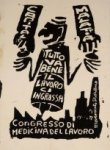
1968 |
[Point n° 7 de la déclaration du Living-theatre]
[Point n° 7 de la déclaration du Living-theatre]. — Avignon : Atelier populaire d’Avignon, . — 1 affiche (sérigr. ), coul. (une : noir , papier blanc ) ; 84 × 65 cm.
sources :
[Polizia fascismo mostra : film poliziesco]
[Polizia fascismo mostra : film poliziesco]. — Venezia Venise : [s.n.], [ca ]. — 1 affiche (sérigr. ), coul. (une : bleu , papier blanc ) ; 70 × 50 cm.
sources :
[Primo maggio]
[Primo maggio]. — Venezia Venise : Circolo internazionale di cultura popolare (Venezia), [ ?] (Carven, tip. (Venezia)). — 1 affiche (impr. photoméc.), coul. (deux : rouge , noir , papier blanc ) ; 67 × 47 cm.
sources :
[Renault-Flins : ça continue]
[Renault-Flins : ça continue]. — Paris : Mouvement du 22 Mars ; [et al.], . — 1 affiche (sérigr. ), coul. (une : bleu , papier blanc ) ; 62 × 46 cm.
sources :
[Salaires légers, chars lourds]
[Salaires légers, chars lourds]. — Paris : Atelier populaire des Beaux-Arts (& École nationale supérieure des Beaux-Arts), . — 1 affiche (sérigr. ), coul. (une : rouge , papier blanc ) ; 32 × 49 cm.
sources :
[Travailleurs étudiants, ne soyons pas dupes encore une fois : non à la foire électoraliste]
[Travailleurs étudiants, ne soyons pas dupes encore une fois : non à la foire électoraliste]. — [S.l.] : Regroupement anarchiste, . — 1 affiche (sérigr. ), coul. (une : rouge , papier blanc ) ; 59 × 49 cm.
sources :
[Université populaire]
[Université populaire]. — [S.l.] : Atelier populaire des Beaux-Arts (& École nationale supérieure des Beaux-Arts), . — 1 affiche (sérigr. ), coul. (une : rouge , papier blanc ) ; 78 × 65 cm.
sources :
[1968 espoir…, 1969 perdu... ; non à l’électoralisme ! Le combat ne passe pas par les urnes]
[1968 espoir…, 1969 perdu... ; non à l’électoralisme ! Le combat ne passe pas par les urnes]. — Louviers : Groupes libertaires Normandie : Union des groupes anarchistes de Normandie, [ ?]. — 1 affiche (impr. photoméc.), coul. (deux : rouge , noir , papier blanc ) ; 60 × 40 cm.
sources :
[Appariteurs musclés, vos papiers... Les étudiants et les lycéens défendent les libertés de tous]
[Appariteurs musclés, vos papiers... Les étudiants et les lycéens défendent les libertés de tous]. — Paris ; Vincennes : Comité d’action Vincennes, (Imprimerie spéciale [Impr. spéc.]). — 1 affiche (impr. photoméc.), coul. (une : rouge , papier blanc ) ; 62 × 44 cm.
sources :
[Le petit train de monsieur Kamode, pièce d’André Benedetto]
[Le petit train de monsieur Kamode, pièce d’André Benedetto]. — [S.l.] : [s.n.], . — 1 affiche (sérigr. ), coul. (trois : rouge , noir , bleu , papier blanc ) ; 106 × 44 cm.
sources :
[L’inquisizione esiste tuttora... ...gli anarchici]
[L’inquisizione esiste tuttora... ...gli anarchici]. — Roma Rome : [s.n.], . — 1 affiche (impr. photoméc.), coul. (une : bleu , papier blanc ) ; 70 × 50 cm.
sources :
[Mystag]
[Mystag] / James Hodges. — Paris : Mystag, [ & ante] (Harfort, impr.). — 1 affiche (lithogr. ), coul. (trois : rouge , noir , jaune , papier blanc ) ; 120 × 80 cm.
sources :

[ 1969 & ante] |
[No alle armi]
[No alle armi]. — Venezia Venise : Circolo internazionale di cultura popolare (Venezia) : Collettiva dei pittori : Galleria internazionale, [ca ]. — 1 affiche (impr. photoméc.), coul. (deux : rouge , noir , papier blanc ) ; 70 × 47 cm.
sources :
[Theses on the Commune]
[Theses on the Commune]. — New York : Situationist International, [ ?]. — 1 affiche (impr. photoméc.), coul. (deux : rouge , noir , papier blanc ) ; 49 × 13 cm.
sources :
[Universiteit in Limburg]
[Universiteit in Limburg]. — Maastricht Maastricht / Maëstricht : Universet, . — 1 affiche (sérigr. ), coul. (trois : bleu , magenta , vert , papier blanc ) ; 92 × 66 cm.
sources :
[All’esercito dei padroni si risponde signor NO]
[All’esercito dei padroni si risponde signor NO]. — [S.l.] : [s.n.], [ca ]. — 1 affiche (impr. photoméc.), coul. (une : bleu , papier blanc ) ; 94 × 65 cm.
sources :
[And even if it seems to you that you never had so much, that is only the slogan of those who still have much more than you]
[And even if it seems to you that you never had so much, that is only the slogan of those who still have much more than you] / Su Negrin. — New York : Times Change Press, . — 1 affiche (impr. photoméc.), coul. (une : vert , papier blanc ) ; 53 × 41 cm.
sources :
[Avec tes camarades PCF-CGT sous le signe, pour baiser les révolutionnaires]
[Avec tes camarades PCF-CGT sous le signe, pour baiser les révolutionnaires]. — [S.l.] : [s.n.], [ca ]. — 1 affiche (sérigr. ), coul. (deux : rouge , noir , papier blanc ) ; 56 × 71 cm.
sources :
[Die Bonzen sind total erstaunt ! Die Sklaven sind noch einmal zurückgekommen]
[Die Bonzen sind total erstaunt ! Die Sklaven sind noch einmal zurückgekommen]. — Biel/Bienne Bienne : Commune autonome, [ca ]. — 1 affiche (sérigr. ), coul. (une : rouge , papier blanc ) ; 32 × 25 cm.
sources :

[ca 1970] |
[Hussein-Arafat : « À la prochaine ! »]
[Hussein-Arafat : « À la prochaine ! »]. — Paris : FA__ [2] (Fédération anarchiste : 1953-....) : FA__. Groupe Louise-Michel (Paris), . — 1 affiche (sérigr. ), coul. (une : rouge , papier blanc ) ; 62 × 42 cm.
sources :
[Italie : la bourgeoisie joue la carte du fascisme pour étouffer la lutte du prolétariat. Valpreda est innocent]
[Italie : la bourgeoisie joue la carte du fascisme pour étouffer la lutte du prolétariat. Valpreda est innocent]. — Paris : [s.n.], [ca ] (Gondoles, impr. des (Choisy-le-Roi : 1956-2006)). — 1 affiche (impr. photoméc.), coul. (deux : rouge , noir , papier blanc ) ; 45 × 28 cm.
sources :

1971 |
[Je suis objecteur de conscience]
[Je suis objecteur de conscience]. — Paris : SOC_ (Secrétariat des objecteurs de conscience), [ ?]. — 1 affiche (sérigr. ), coul. (une : rouge , papier blanc ) ; 93 × 62 cm.
sources :
[Jeune ! la loi de permet de choisir l’objection de conscience]
[Jeune ! la loi de permet de choisir l’objection de conscience]. — Paris : SOC_ (Secrétariat des objecteurs de conscience), [ca ]. — 1 affiche (sérigr. ), coul. (une : rouge , papier blanc ) ; 62 × 60 cm.
sources :
[Journal communiste libertaire : Front libertaire des luttes de classes]
[Journal communiste libertaire : Front libertaire des luttes de classes]. — Paris : Front libertaire des luttes de classes : ORA_ (Organisation Révolutionnaire Anarchiste : 1967-1976), [ca ] (Imprimerie spéciale [Impr. spéc.]). — 1 affiche (impr. photoméc.), coul. (deux : rouge , noir , papier blanc ) ; 57 × 44 cm.
sources :
[L’antinebbia, Lotta continua ; sottoscrivi per creare un centro stampa a Milano]
[L’antinebbia, Lotta continua ; sottoscrivi per creare un centro stampa a Milano]. — Milano Milan : Lotta continua, [ca ]. — 1 affiche (impr. photoméc.), coul. (deux : rouge , noir , papier blanc ) ; 86 × 58 cm.
sources :
[La polizia di Milano come quella di Franco]
[La polizia di Milano come quella di Franco]. — Milano Milan : FAI_ (Federazione anarchica italiana) : Umanità nova, . — 1 affiche (impr. photoméc.), coul. (deux : rouge , noir , papier blanc ) ; 85 × 59 cm.

